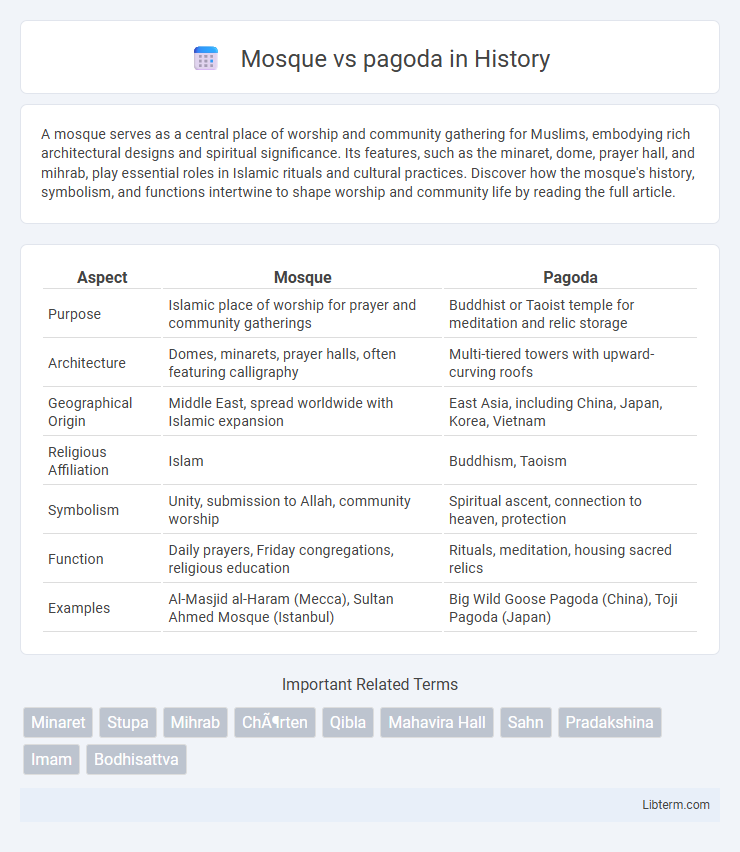A mosque serves as a central place of worship and community gathering for Muslims, embodying rich architectural designs and spiritual significance. Its features, such as the minaret, dome, prayer hall, and mihrab, play essential roles in Islamic rituals and cultural practices. Discover how the mosque's history, symbolism, and functions intertwine to shape worship and community life by reading the full article.
Table of Comparison
| Aspect | Mosque | Pagoda |
|---|---|---|
| Purpose | Islamic place of worship for prayer and community gatherings | Buddhist or Taoist temple for meditation and relic storage |
| Architecture | Domes, minarets, prayer halls, often featuring calligraphy | Multi-tiered towers with upward-curving roofs |
| Geographical Origin | Middle East, spread worldwide with Islamic expansion | East Asia, including China, Japan, Korea, Vietnam |
| Religious Affiliation | Islam | Buddhism, Taoism |
| Symbolism | Unity, submission to Allah, community worship | Spiritual ascent, connection to heaven, protection |
| Function | Daily prayers, Friday congregations, religious education | Rituals, meditation, housing sacred relics |
| Examples | Al-Masjid al-Haram (Mecca), Sultan Ahmed Mosque (Istanbul) | Big Wild Goose Pagoda (China), Toji Pagoda (Japan) |
Introduction to Mosques and Pagodas
Mosques serve as places of worship in Islam, characterized by architectural elements such as minarets, domes, and prayer halls oriented towards Mecca. Pagodas are tiered towers commonly found in East Asia, associated with Buddhist temples and used for religious rituals and meditation. Both structures reflect distinct cultural and spiritual traditions, with mosques emphasizing communal prayer and pagodas symbolizing sacred Buddhist principles.
Historical Origins: Mosque vs Pagoda
Mosques originated in the 7th century as places of worship for early Muslims, reflecting Islamic architectural principles and serving as community centers in cities across the Middle East and later expanding worldwide. Pagodas, on the other hand, evolved from ancient Indian stupas during the early centuries CE, becoming prominent in East and Southeast Asia as tiered towers associated with Buddhist religious practices and the preservation of sacred relics. The historical development of mosques is closely tied to Islamic religious and social practices, while pagodas embody the architectural adaptation of Buddhist symbolism and cultural integration in various Asian regions.
Architectural Features and Styles
Mosques feature large domes, minarets, and expansive prayer halls oriented towards Mecca, often adorned with intricate arabesque patterns and calligraphy. Pagodas typically exhibit tiered towers with multiple eaves, emphasizing verticality and symmetry, often constructed with wood or stone and decorated with Buddhist motifs. Both architectural styles reflect religious symbolism and cultural aesthetics unique to Islamic and East Asian traditions.
Symbolism and Religious Significance
Mosques symbolize the unity of the Islamic faith, serving as places for communal prayers, reflection, and the embodiment of submission to Allah, often featuring architectural elements like minarets and domes that signify divine presence. Pagodas represent sacred structures in Buddhism and East Asian traditions, symbolizing enlightenment, spiritual ascension, and the preservation of sacred relics, characterized by tiered towers that reflect the connection between earth and heaven. Both structures function as focal points for worship and community gathering, deeply embedded with religious symbolism unique to their respective faiths.
Geographic Distribution and Cultural Influence
Mosques predominantly appear throughout the Middle East, North Africa, and parts of South Asia, reflecting Islamic cultural and religious influence in these regions. Pagodas are primarily found in East and Southeast Asia, including China, Japan, Korea, and Vietnam, symbolizing Buddhist architectural and spiritual traditions. Both structures serve as focal points for worship and community gathering, embodying the distinct cultural identities and religious practices of their geographic areas.
Rituals and Practices
Mosques serve as central places for Islamic worship, hosting daily prayers, Friday congregational prayers (Jumu'ah), and ceremonies like Ramadan fasting and Eid celebrations. Pagodas primarily function as spiritual sites in Buddhism, where rituals include incense offerings, meditation, chanting sutras, and ceremonies during Vesak and other Buddhist festivals. The distinct architectural designs of mosques and pagodas facilitate their specific religious rituals and community practices.
Roles in Community Life
Mosques serve as central places of worship and community gathering for Muslims, facilitating daily prayers, religious education, and cultural events that strengthen communal bonds. Pagodas, primarily found in East Asian Buddhist communities, function as spiritual landmarks and sites for meditation, religious ceremonies, and preservation of sacred relics, promoting communal harmony and cultural heritage. Both structures play vital roles in fostering social cohesion and spiritual growth within their respective communities.
Interior Design and Sacred Spaces
Mosques feature spacious prayer halls with minimalist decoration emphasizing geometric patterns, arabesques, and calligraphy to foster a sense of divine presence and spiritual focus. Pagodas often exhibit intricate woodwork, ornate carvings, and layered eaves, creating vertical sacred spaces that symbolize harmony between heaven and earth. Both interiors prioritize natural light and spatial orientation--mosques align towards Mecca for prayer, while pagodas often serve as relic enclosures or meditation spaces within Buddhist temple complexes.
Preservation and Modern Adaptations
Mosques often undergo preservation efforts emphasizing the maintenance of intricate Islamic calligraphy and geometric patterns, while integrating modern HVAC systems to enhance comfort during prayers. Pagodas are preserved by reinforcing wooden structures and applying traditional lacquer techniques, often incorporating seismic retrofitting to withstand natural disasters without altering the iconic tiered roofs. Both architectural forms balance historical integrity with contemporary needs by adopting materials and technologies that preserve cultural symbolism while ensuring durability.
Key Differences and Similarities
Mosques and pagodas both serve as religious structures but differ fundamentally in architecture and purpose; mosques are Islamic places of worship featuring domes, minarets, and prayer halls oriented towards Mecca, while pagodas are traditionally East Asian, multi-tiered towers associated with Buddhist practices and often serve as shrines or reliquaries. Both structures symbolize spiritual devotion and community gathering, yet mosques emphasize collective prayer rituals, whereas pagodas often act as meditation sites or monuments reflecting Buddhist cosmology. Material and design elements also vary, with mosques commonly built using stone and marble, integrating calligraphy and geometric patterns, and pagodas utilizing wood or stone with ornate, upward-curving eaves.
Mosque Infographic

 libterm.com
libterm.com